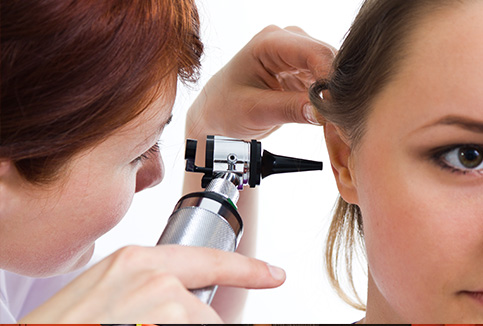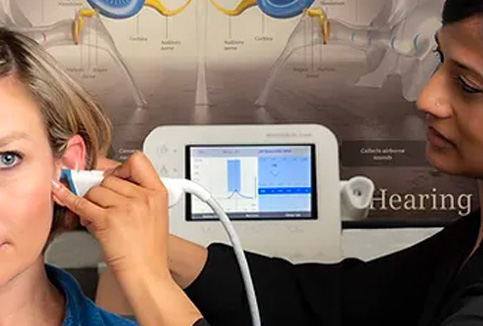Tweed Heads +61 7 5513-0338
Mt Ommaney +61 7 3310-4581
Runaway Bay +61 7 5529-3530
Hyperdome +61 7 5439-0809
Victoria Point +61 7 3207-6247
Mon-Fri, 9AM – 5:30PM
Hearing Tests
We offer a range of hearing assessments at Australian Audiology Services, including: free hearing checks, full diagnostic assessments, pre-employment tests, worker compensation assessments, and scuba diving tests.
The range of techniques used will depend on the reason that you have come to see us.
Free hearing check*
Come in at any time to find out if hearing loss is causing of you difficulties. This is achieved with a free, 5-minute hearing check, which you can do yourself within a few minutes using our touchscreen screeners.
A video guide will walk you through a hearing check that aims to find the lowest volume of sounds that you can hear at frequencies important to human hearing. Your results will be shown on the screen and a copy will be sent to you via email.
If your free hearing check indicates a significant hearing loss, we will recommend a full clinical hearing test and consultation with one of our audiologists.
* No appointment necessary.

Otoscopic Inspection
This simply involves looking into the ear canal using an otoscope to check the condition of the ear canal and eardrum.
It helps identifies if there are any visible problems that may influence the results of hearing tests, such as: perforation in the tympanic membrane (eardrum), ear infections, and impacted ear wax.

Pure Tone Audiometry
Air conduction tests
The simplest way to test hearing is called pure tone audiometry. This involves sitting in a soundproof booth (see photo) and being played a series of beeps and whistles, called pure tones, through headphones or earphones and indicating when you can hear them, generally by pressing a button.
The loudness of each tone is reduced until you can just hear the tone. The purpose of the test is to find the quietest sounds that you can hear at the full range of frequencies common to human speech, usually 250 Hz to 8000 Hz.
The quietest sounds you can hear, known as hearing thresholds, will be marked on a graph called an audiogram.

Bone conduction tests
The sensitivity of the cochlea can also be tested by placing a small vibrator on the mastoid bone behind the ear and, once again, measuring the softest sounds that can be heard. Sounds presented this way travel through the bones of the skull to the cochlea and hearing nerves, bypassing the middle ear.
This type of testing is called bone conduction. A comparison of air conduction and bone conduction hearing levels can tell us a lot about where a hearing problem is being caused.
Reasons could include: sensory damage over time, fluid in the middle ear, excessive earwax, a perforated tympanic membrane, or misfunctioning bones of the middle ear.
Speech Tests
The ability to hear speech is a function of the both your ability to detect and understand the sounds of speech. The range of audible sounds, not just the degree of hearing loss, varies considerably from person to person. Unfortunately, when hearing is damaged it is usually not just the volume of sound heard that is lost, often the quality of the sound is also distorted.
Speech tests are used to determine how clearly someone can understand speech, when visible cues such as lip-reading are removed. They usually involve using common lists of words played (or spoken) at a constant volume that are appropriate to the client’s hearing loss. The client responds by guessing the word that was spoken and correct and incorrect answers are tallied.
Speech-in-Noise Tests
Given that people with hearing loss commonly have the greatest difficulty understanding speech in the presence of background noise; it makes sense that speech discrimination tests are also performed with the addition of a “noise” stimulus. This is often a ‘speech babble’ played at different volumes relative the speech volume (words or phrases). The client responds by guessing the word or phrase that was spoken in the presence of background noise, and results are tallied.
Aided Vs Unaided Tests
Following the fitting of a hearing device, an Audiologist will run the tests again to compare how their client is able to perform in the speech discrimination tests with the benefit of a hearing aid compared to when they are not wearing a hearing aid.
Tympanograms & Reflex Tests
Tympanograms measure the movement and flexibility of the tympanic membrane to identify whether it is moving normally.
Results may indicate a problem in the middle ear that can cause a conductive hearing loss. When a child has a normal tympanogram, it may also be possible to test for the presence of a muscle reflex – acoustic reflex – in the middle ear.
The absence of this reflex to different sounds gives information about the functioning of the auditory system.

Request an appointment today!
Australian Audiology Services are here for all of your hearing care needs. Call us today on 1300 864 327, or complete the form below. One of our team will will be in touch as soon as possible to answer your questions, or to schedule an appointment at one of our hearing centres.
